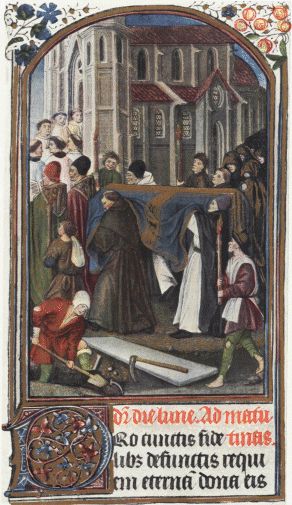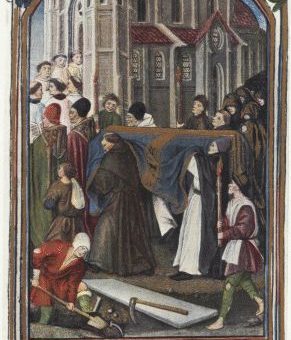
For more than a hundred years, Agnes Strickland was considered the ultimate source…but now we know better how she got a bunch of things wrong (as did many biographers of her era – including her French counterpart who made me groan with almost every line of my translation). And while we have to kind of squint at anything she tells us, it’s still fun. Like her take on Mary’s funeral, which took place a little less than a month after her death on November 17…
Agnes describes how Mary’s body had arrived at the abbey the night of the 13th, that it was brought immediately to be placed on the hearse (“which, it must always be remembered, was erected in the abbey, near or over the grave”) and then
…watched the livelong night of December 13th. A hundred poor men in good black gowns and hoods, bearing long torches, with the queen’s guard in black coats, bearing staff torches, stood round the hearse that night; and wax chandlers were in attendance to supply any torches that burnt out.
Agnes Strickland, Lives of the Queens of England – Mary I
Right after this Agnes went a bit off the rails: she quoted Strypes Memorials to describe the standard ceremony in which the dead monarch’s officers break their staves to mark the end of their service, but decided that Strypes’ use of a stray “her grace” proved that Elizabeth attended (no other historian believes Elizabeth violated longstanding custom) Then Agnes waxed poetical about the “uproar and confusion” surrounding the conclusion of “the last royal funeral conducted according to the rites of the Roman church in England” (she even used the term “hurly burly”). Well worth a read:
The next morning, December 14, was the queen’s mass, and all the mourners offered; and the queen’s body-armor, her sword, her helmet, her target, her banner of arms, and three standards were all offered, her heralds standing round her coffin. The bishop of Winchester preached a most remarkable funeral sermon for the deceased queen, being often interrupted by his tears: the historical circumstances attending this oration prove that queen Elizabeth was present at the ceremony. The herald, who is our guide in this curious ceremonial, proceeds to say, “Then her grace was carried up to that chapel king Henry VII builded, attended by mitred bishops. When the heralds broke their staffs, and flung them into her grave all the people plucked down the hangings and the armorial bearings round about the abbey; and every one of them tore him a piece, as large as he could catch it.” What a sense of uproar and confusion must have concluded the last royal funeral conducted according to the rites of the Roman church in England! However, the archbishop of York, in the midst of the hurly burly, “proclaimed a collation; and, as soon as he finished, the bishops, abbot Feckenham, the lords, ladies, and knights went into the abbey to dinner.”
Agnes Strickland, Lives of the Queens of England – Mary I
***
If you like my posts, you’ll love my books! My Seymour Saga trilogy tells the gripping story of the short-lived dynasty that shaped the Tudor Era. Jane the Quene skews romantic, The Path to Somerset is pure Game of Thrones (without the dragons), and The Boy King is a noir coming-of-age. Get them now through Amazon, Barnes & Noble, Kobo, and Apple, or even your local independent bookstore!

(PS Already read them? Did you love them? Then please review them – even just a stars rating! It makes a huge difference in helping new readers find them and would mean the world to me!)

Be First to Comment